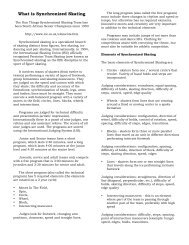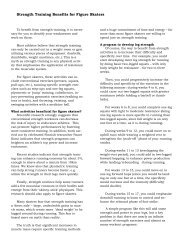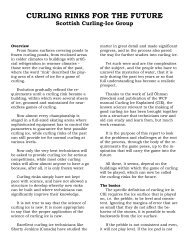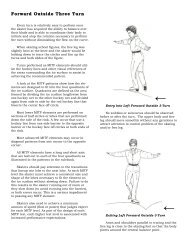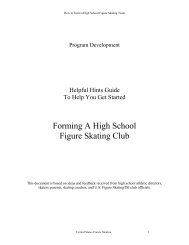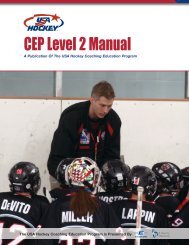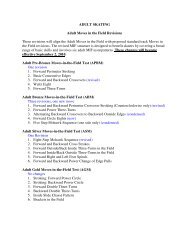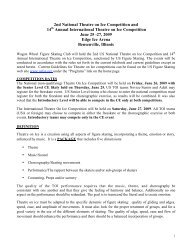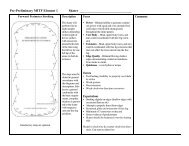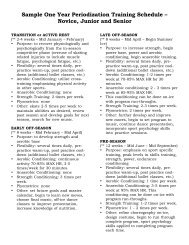CEP Level 3 Manual - Rushmore Hockey Association
CEP Level 3 Manual - Rushmore Hockey Association
CEP Level 3 Manual - Rushmore Hockey Association
Create successful ePaper yourself
Turn your PDF publications into a flip-book with our unique Google optimized e-Paper software.
T A B L E O F C O N T E N T SSOCIAL AC<strong>CEP</strong>TANCESocial acceptance is the extent to which otherpeople make athletes feel they are accepted asimportant persons.Coaches can make athletes feel accepted by:• showing a genuine interest in how they aregetting along in situations outside of hockey(e.g., at school, work, or home).• warmly greet the players each time that yousee them.• talking with each athlete individually atevery practice and game.• joking with them (but do not be a clown tothem).• asking their advice in certain areas (e.g.,warm-ups).• listening attentively to what the athleteshave to say.• being willing to help the players solvepersonal problems.As a coach, you can do a lot to assist athletes inthe development and acceptance of high levels ofself-esteem by demonstrating a genuine interest ineach athlete as a person and a hockey player.FOR THE COACHYou have an athlete who has a low level of selfesteem.What can you specifically say and do toshow acceptance of this athlete as a hockey playerand a person?_________________________________________________________________________________________________________________________________________________________________________________________________________________________________________________________________________________________________________________________________________________________________________________________________________________________________________________________________________________________SOCIAL REINFORCEMENTSocial reinforcement refers to the positive ornegative feedback that an athlete receives fromother people.• Feedback consists of the information whichindividuals transmit to an athlete by whatthey say and do.• Young athletes are constantly seekinginformation about how well they are doing.Their coach’s, peers, and parent’scomments and gestures are importantsources of such information.• Positive reinforcement (praise orencouragement) will usually help thedevelopment of a positive self-esteem,whereas constant criticism or lack of interestin players will have a negative effect on thedevelopment of their self-esteem.• Remember, praise is the highest form ofmotivation.As a coach, try to use a lot of positivereinforcement to help players build high levels ofself-esteem.POSITIVE REINFORCEMENTPositive reinforcement consists of any form ofpraise or encouragement which indicates approvalof what an athlete is doing.• Praise should be provided for good effort aswell as good performance.• Praise should be specific rather thangeneral.• Following a mistake in a game, a coachshould show patience and explain to theplayer exactly what the error was and howto correct the error. Play the individual onthe next shift to show your confidence in theathlete.• Encouragement should be provided whenathletes are working on new skills, especiallyafter mistakes or setbacks.• Use gestures such as a pat on the back, asmile, a wink, a nod of the head, or athumbs-up sign to indicate approval.• Encourage teammates to give one anotherpositive feedback.• Provide constructive feedback which willhelp the player improve performance.• Do not use too much positive reinforcementor it will lose its effect. Make sure yourpositive feedback is sincere and meaningful.• Set goals for each player which are specific,measurable, and attainable.• Make sure that players feel that they haveimportant roles on the team. Define the rolefor each athlete in a specific manner.NEGATIVE REINFORCEMENTNegative reinforcement consists of any type ofcriticism or punishment which indicates disapprovalof what an athlete is doing.• If you must use criticism, make sure it isdirected at a specific, undesirable actionthat you want to eliminate. It should not beinterpreted by an athlete as a comment ontheir worthiness as a person.• Negative comments should always beaccompanied by specific correctiveinformation.For example:Never just say “Don’t do that.” Instead, youshould:• explain to the players what they have donecorrectly.• explain to the players precisely what theyhave done wrong.• offer clear, corrective advice which showsthem how to carry out the desired behavior.• offer encouragement.As another example:If the centre on a line is a right-hand shot and hasa tendency to use a forehand pass (rather than abackhand pass) to the right winger, you should notjust say “Don’t use a forehand pass, use a backhandpass.” Rather, you should explain that:• by turning to the forehand to pass to yourright winger, you are taking too long toexecute the pass and are telegraphing yourintentions, thereby giving the opposingplayer time to intercept the pass.• by using a backhand pass, you will be ableto execute the pass more quickly and thusincrease the chances of success.• players at all levels make this basic mistakeand must practice their skill.Remember, following a mistake, offer correctivefeedback and encouragement.FOR THE COACHYou have a hockey player who is a weak skater.How can you use positive reinforcement to help theplayer develop positive self-esteem and perhapsimprove the athlete’s skating skills?_________________________________________________________________________________________________________________________________________________________________________________________________________________________________________________________________________________________________________________________________________________________________________________________________________________________________________________________________________________________Select one of the skills you teach your players.Identify a common error that occurs when athletesperform this skill. Would you use positive ornegative reinforcement to correct the error? Whatfeedback would you give to the players?Skill: ___________________________________Common error: __________________________Use of positive or negative reinforcement:_____________________________________Feedback given: ________________________________________________________________________________________________________________________________________42 | USA <strong>Hockey</strong> Coaching Education Program <strong>Level</strong> 3 <strong>Manual</strong>Sport Psychology | 43



